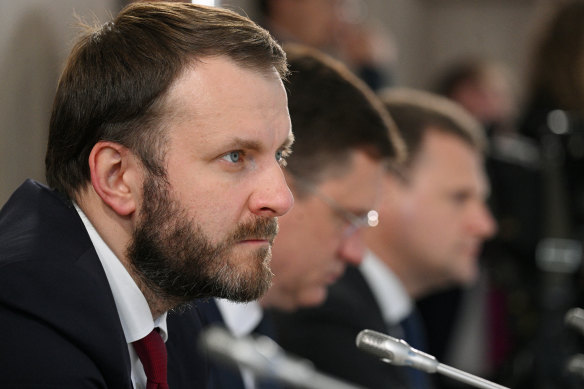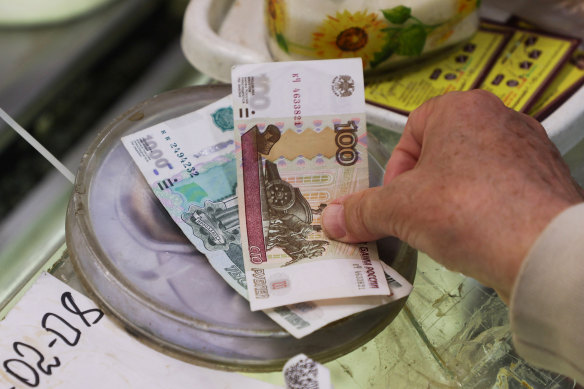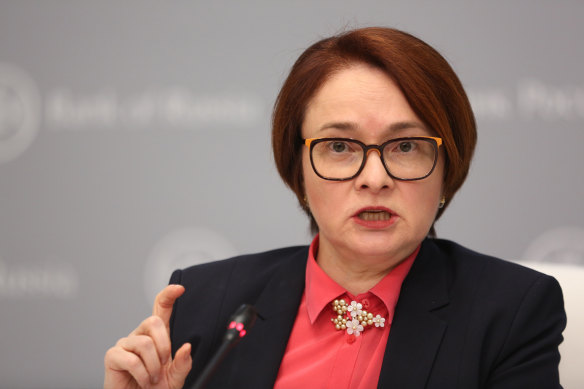Save articles for later
Add articles to your saved list and come back to them any time.
Russia’s central bank called an extraordinary meeting after the rouble crashed through the level of 100 to the dollar for the first time since March of last year as Russia’s war in Ukraine drags on and international sanctions hit trade.
The central bank hiked its key rate by a percentage point to 8.5 per cent last month, the first increase since emergency measures imposed immediately after the invasion of Ukraine in February 2022.
Russian President Vladimir Putin’s economic aide Maxim Oreshkin has blamed Russia’s central bank for the declining value of the rouble.Credit: Reuters
The exchange rate has emerged as the barometer of health for an economy battered by shrinking export revenues and its isolation from international financial markets, bringing infighting between the government and central bank into the open.
The rouble reversed losses after the announcement, and is fetching around 102 to the US dollar at 6am AEST. The currency has weakened about 25 per cent this year for the third-worst performance in emerging markets. The central bank had sought to arrest the slump by saying it won’t purchase foreign currency on the domestic market for the rest of 2023.
Kremlin economic aide Maxim Oreshkin blamed the central bank for contributing to the depreciation, an unusual rebuke made public just moments before the Russian currency broke through 100 to the dollar. Bank of Russia Governor Elvira Nabiullina has repeatedly cited deterioration in trade as the main reason for the rouble’s weakness.
Writing in a rare column published by state news agency Itar-Tass, President Vladimir Putin’s chief economic adviser said “the source of the weakening of the rouble and the acceleration of inflation is soft monetary policy.”
Policymakers have the necessary tools to normalise the currency value in the near future, he said.
“A weak rouble complicates the economy’s structural transformation and negatively affects the population’s real incomes.”
“It is in the interests of the Russian economy to have a strong rouble.”
Earlier on Monday, the central bank repeated that it currently doesn’t see any threats to financial stability from the rouble’s performance and allows for the possibility of raising interest rates at its coming meetings.
The rouble is one of the worst-performing currencies this year.Credit: Reuters
The value of exports is facing a “significant reduction” at a time when demand for imports is on the rise against the background of elevated government spending and also as a result of fast lending growth, it said in a statement.
The public airing of grievances hints at discord in the highest echelons of the Russian establishment over how to respond to a crash in the rouble that pulled it to levels last seen weeks after the invasion of Ukraine in February 2022.
The central bank announced last week it wouldn’t buy foreign currency on the domestic market under a budgetary mechanism that was put in place to insulate the economy from swings in commodity prices. The decision aimed to “reduce the volatility of financial markets,” it said.
“The weakening of the rouble is the result of the international screws tightening around the Russian economy, but also the cost of keeping the economy going.”
The suspension of foreign-exchange purchases “has failed to stabilise the currency,” according to JPMorgan Chase & Co., which now expects the central bank to raise its benchmark to 10 per cent by the end of the year, up from its previous call for 9 per cent.
The central bank continues to adhere to a floating exchange-rate policy that “allows the economy to adapt effectively to changing external conditions,” Deputy Governor Alexey Zabotkin told reporters on Friday.
Budget situation
But in what amounted to a defence of government policies, Oreshkin said authorities “managed to stabilise the budget situation” and expect to run a surplus in the third quarter, with the year-end deficit seen in line with the planned 2 per cent of gross domestic product.
In the remainder of the year, the amount of extra proceeds from oil and gas sales will reach about 800 billion roubles ($12.5 billion) above a baseline level in the budget, allowing the government to rely less on its wealth fund to cover the fiscal deficit, he said.
Bank of Russia Governor Elvira Nabiullina has repeatedly cited deterioration in trade as the main reason for the rouble’s weakness but she has been criticised by the Kremlin.Credit: Bloomberg
Revenues of Russian oil and gas exporters declined to $US6.9 billion ($10.6 billion) in July from $US16.8 billion in the same period last year, according to the latest central bank data. An easing of restrictions on moving money abroad has also led to accelerated capital flight as Russians race to shift funds into foreign accounts.
“The weakening of the rouble is the result of the international screws tightening around the Russian economy, but also the cost of keeping the economy going,” said Erik Meyersson, chief emerging-market strategist at SEB AB in Stockholm.
“Nobody wants to hold roubles, and the limited supply of foreign exchange from exporters weighs on the currency.”
Bloomberg
The Business Briefing newsletter delivers major stories, exclusive coverage and expert opinion. Sign up to get it every weekday morning.
Most Viewed in Business
From our partners
Source: Read Full Article



